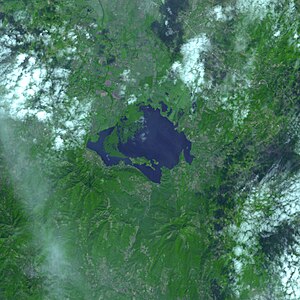Laguna de Olomega
| Laguna de Olomega | ||
|---|---|---|

|
||
| Satellite image of Laguna de Olomega (NASA). | ||
| Geographical location | El Salvador | |
| Tributaries | Río Grande de San Miguel | |
| Drain | Río Grande de San Miguel | |
| Location close to the shore | San Miguel | |
| Data | ||
| Coordinates | 13 ° 19 '0 " N , 88 ° 4' 0" W | |
|
|
||
| surface | 24.2 km² | |
Laguna de Olomega is the largest freshwater lake in the eastern part of El Salvador .
The area of the freshwater lake is 24.2 km². It is located 15 km southeast of San Miguel . The lake is fed by the Río Grande de San Miguel . It supplies water to around 9,000 people in the communities of Chirilagua (San Miguel) and El Carmen ( La Unión ).
The adjacent wetland with a total area of around 7.6 hectares with mangrove forests is home to numerous threatened species. In addition to various species of fish, such as Cichlasoma trimaculatum , Managua cichlid ( Parachromis managuensis ) and the black-throated cichlid ( Amatitlania coatepeque ), there are breeding grounds for various bird species on the banks of the Laguna, such as the white heron ( great egret ), the plover , the Olive shag and also rare frog species.
environment
Due to over-fertilization of the plantation areas in the lake area, eutrophication has increased extremely, which leads to the so-called weed growth of the freshwater lake. The main share is made up of the water hyacinth family , they displace other species and increasingly weed the water. At the water's edge, eutrophication also changes the other plant communities growing here.
Since 2011, the “Ministerio de Medio Ambiente y Recursos Naturales” has started to counteract further eutrophication through suitable measures as part of the “Plan Nacional de Humedales”.
Web links
- Laguna de Olomega on the website of the Ministerio de Medio Ambiente y Recursos Naturales
